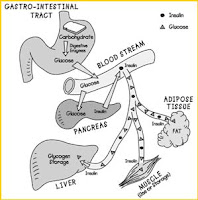
Diabetes mellitus is a group of metabolic diseases characterized by high blood sugar (glucose) levels, that result from defects in insulin secretion, or action, or both. Diabetes mellitus, commonly referred to as diabetes (as it will be in this article) was first identified as a disease associated with "sweet urine," and excessive muscle loss in the ancient world. Elevated levels of blood glucose (hyperglycemia) lead to spillage of glucose into the urine, hence the term sweet urine.
Normally, blood glucose levels are tightly controlled by insulin, a hormone produced by the pancreas. Insulin lowers the blood glucose level. When the blood glucose elevates (for example, after eating food), insulin is released from the pancreas to normalize the glucose level. In patients with diabetes, the absence or insufficient production of insulin causes hyperglycemia. Diabetes is a chronic medical condition, meaning that although it can be controlled, it lasts a lifetime.(medicinenet.com)
Nursing Diagnosis for Diabetes Mellitus
Imbalanced Nutrition: More than Body Requirements related to intake in excess of activity expenditures
Nursing Interventions for Diabetes Mellitus
- Assess current timing and content of meals.
- Assist patient to identify problems that may have an impact on dietary adherence and possible solutions to these problems. Emphasize that lifestyle changes should be maintainable for life.
- Assist patient to establish goals for weekly weight loss and incentives to assist in achieving them.
- Advise patient on the importance of an individualized meal plan in meeting weight-loss goals. Reducing intake of carbohydrates may benefit some patients; however, fad diets or diet plans that stress one food group and eliminate another are generally not recommended.
- Discuss the goals of dietary therapy for the patient. Setting a goal of a 10% (of patient’s actual body weight) weight loss over several months is usually achievable and effective in reducing blood sugar and other metabolic parameters.
- Explain the importance of exercise in maintaining/reducing body weight.
- Caloric expenditure for energy in exercise
- Carryover of enhanced metabolic rate and efficient food utilization
- Strategize with patient to address the potential social pitfalls of weight reduction.
Nursing Diagnosis for Diabetes Mellitus
Risk for Injury (hypoglycemia) related to effects of insulin, inability to eat
Nursing Interventions for Diabetes Mellitus
- Assess patient for the signs and symptoms of hypoglycemia.
- Adrenergic (early symptoms) sweating, tremor, pallor, tachycardia, palpitations, nervousness from the release of adrenalin when blood glucose falls rapidly
- Neurologic (later symptoms) light-headedness, headache, confusion, irritability, slurred speech, lack of coordination, staggering gait from depression of central nervous system as glucose level progressively falls.
- Assess patient for cognitive or physical impairments that may interfere with ability to accurately administer insulin.
- Closely monitor blood glucose levels to detect hypoglycemia.
- Instruct patient in the importance of accuracy in insulin preparation and meal timing to avoid hypoglycemia.
- Encourage patient to carry a portable treatment for hypoglycemia at all times.
- Between-meal snacks as well as extra food taken before exercise should be encouraged to prevent hypoglycemia.
Source : http://nursinginterventions-diagnosis.blogspot.com/2011/03/nursing-interventions-for-diabetes.html
